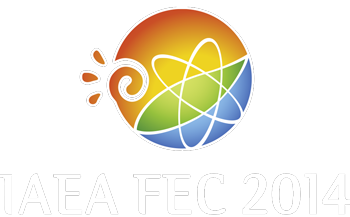Speaker
Mr
James Paul Gunn
(CEA Cadarache)
Description
ITER will begin operation with a full W divertor consisting of solid W monoblocks (MB) bonded to CuCrZr water-carrying cooling tubes. We seek to predict heat flux distributions on MBs comparing three models: optical calculations, ion orbit calculations, and PIC. The consequences of five design aspects are analyzed in terms of available models:
(1) Divertor target tilting to shadow leading edges at inter-cassette gaps leads to increased local power flux and total power to wetted MBs, as well as to reduced margin against surface melting during fast transients, due to the increased B-field angle (the total power to each target is the same, but it is distributed among fewer MBs).
(2) Within a single tilted target, chamfering foreseen to protect leading edges of the MBs against misalignments also leads to increased local power flux due to the increased B-field angle, but that is exactly compensated by a reduction of the wetted area, thus the total power to individual MBs is conserved. ANSYS thermal simulations predict additional heating of MB trailing edges due to non-uniform heat flux deposition.
(3) Relative misalignments between plasma-facing units (PFU) play a critical role in the total power incident on a single MB. A MB on a PFU that is radially misaligned by 0.3 mm on a tilted target (see 1) will collect a total convected plasma power that is 50% higher than a perfectly aligned MB on an untilted target. If that power were spread uniformly over the top surface of the MB, it would be equivalent to a power flux that is 50% higher than the specified limits. There is no shaping solution that can remedy this problem.
(4) Due to their large Larmor radii, ions released from the pedestal during ELMs can strike magnetically shadowed poloidal edges. The fraction of ELM parallel power flux that penetrates into gaps is independent of ion temperature over the range 0.5keV<T_i,<5keV. According to the ion orbit model, energetic ELMs can cause leading edge melting.
(5) Unintuitive focusing of power onto the edges of toroidal gaps due to finite Larmor radius and sheath electric fields causes overheating. According to the ion orbit model, this can cause toroidal edge temperatures to attain the W recrystallization range for steady state loads, and melting of toroidal edges for both slow and fast transient loads.
| Country or International Organisation | France |
|---|---|
| Paper Number | FIP/1-2Rb |
Author
Mr
James Paul Gunn
(CEA Cadarache)
Co-authors
Dr
Andre Kukushkin
(ITER Organization)
Dr
Frederic Escourbiac
(ITER Organization)
Dr
Martin Kocan
(ITER Organization)
Michael Komm
(Institute of Plasma Physics)
Dr
Renauc Dejarnac
(Institute of Plasma Physics)
Richard Pitts
(ITER Organization)
Dr
Sophie Carpentier-Chouchana
(EIRL S. Carpentier-Chouchana)
Dr
Takeshi Hirai
(ITER Organization)
Dr
Victor Komarov
(ITER Organization)
Zhao Wei
(Southwest Institute of Physics)

